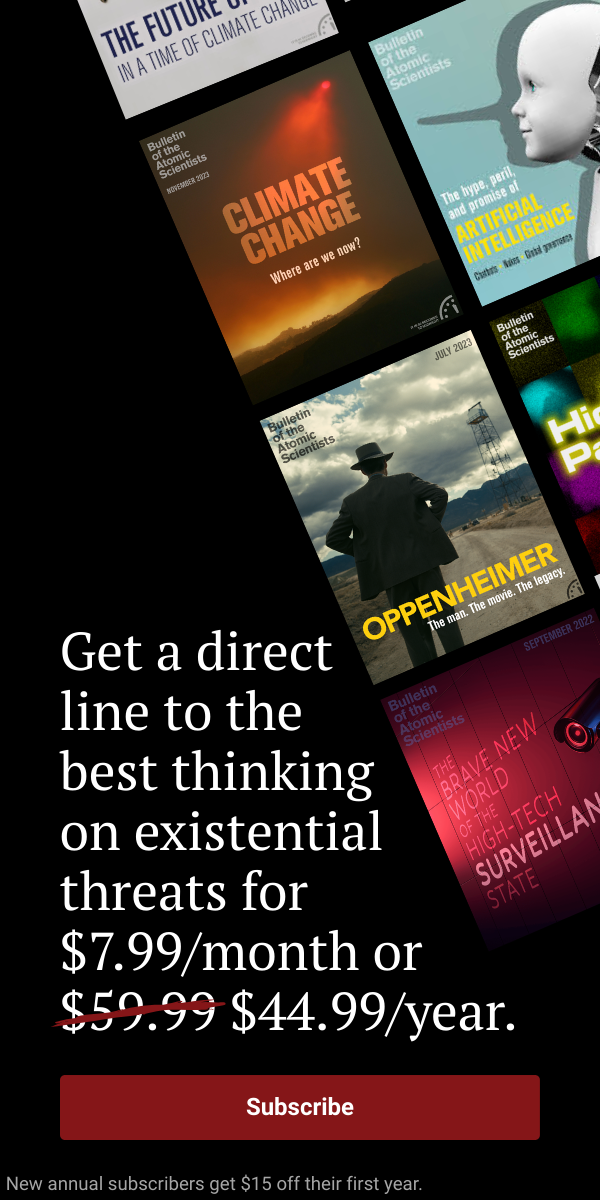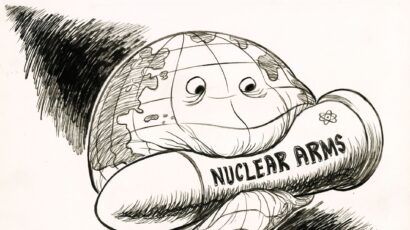One scientist’s do-it list for presumptive Energy Secretary Perry
By Jeff Terry | January 16, 2017

Future Energy Secretary Perry:
As a scientist who has spent over 25 years working at, in, and around the US Energy Department, let me express to you my hope that you will fix some of the problems at the agency you will soon run. By now you have almost certainly learned that “Energy Department” is one of the biggest misnomers of all time. So let me be the first to congratulate you on your appointment to run the Department of Nuclear Weapons and Legacy Environmental Waste Cleanup. Yes, the department’s budget request for 2017 slates about $13 billion for nuclear security and $7 billion for environmental management—combined, that comes to about 61 percent of the total $33 billion request. Once during a long-ago political campaign, you spoke of wanting to shut down Energy, but if you’ve become aware of its actual purpose, you may now see why this would be very difficult. Given current defense policy, nuclear weapons will be around for the foreseeable future, so you can’t just stop maintaining them. Nor can the government walk away from cleaning up nuclear waste at sites like Hanford in Washington State, where plutonium was created for use in the Manhattan Project. Since the department will be around for a while, we may as well examine some of the problems and potential solutions.
Some critics have complained that you are neither a scientist nor an engineer, but to be honest, that doesn’t bother me in the least: The department cannot claim many spectacular successes over the time it was run by scientists and engineers. In fact, Energy faces some significant difficulties, which almost anyone who has ever worked there can identify. To help you prepare for your new position, let me detail a few.
Culture clash. Secretary Perry, your first task should be to change the culture within the Energy Department, which has seen too many setbacks over the last 10 years. These include engineering failures (at the MOX Fuel Fabrication Facility, the Chemistry and Metallurgy Research Replacement Facility, and the Hanford Waste Vitrification Plant); safety problems (a fire and explosion at the Waste Isolation Pilot Plant); and management mistakes (an inability to open a long-term nuclear waste repository and missteps in the small modular reactor award process). In fact, outside of the Energy Department’s Office of Science, which builds and operates most large user facilities (housing highly advanced equipment available to outside researchers), it is hard to point to a major undertaking that has been a resounding success. The Iran Nuclear Agreement is one exception. Your predecessor Ernest Moniz was significantly involved in negotiating that deal, and while I admit to having my reservations about it, early results suggest it is helping to curb the risk of Iranian nuclear proliferation.
Overall, though, the scale of the failures outweighs the successes. That has to do with what I see as a culture of fear. Among staff scientists, there is fear of making mistakes and fear of retribution. When I worked at Los Alamos National Laboratory, we joked that one should not go into the labs on Monday morning or Friday afternoon, so we could avoid making mistakes early or late in the week. This kind of culture doesn’t set the agency up for success, as self-reinforcing fear of minute failures can drown out the big issues that lead to major catastrophes. Safety is important, but it has to be balanced with an understanding of actual risks and the benefits of addressing them. Safety fears should not halt work that has real benefit to society.
How can you change the culture? Begin by valuing and rewarding success. Make everyone’s job simpler by easing up on onerous regulations. And recognize that the runaway budgets characterizing many projects come from overdesign due to fear of safety incidents. The department has some of the best scientists I have ever worked with, but they need to be liberated from the interference that often prevents them from achieving their best.
Stop wrapping scientists in red tape. The Energy Department is responsible for an elite group of laboratories that advance science on energy and nuclear weapons. Most of these 17 federally funded national laboratories are run by private-sector contractors. Three members of the Sandia National Laboratory management team, reviewing past studies of the labs, wrote, “These studies consistently find these laboratories attract very high quality technical personnel who have the capacity to do innovative work. However, their productivity suffers from poor management by DOE, by the contractors who manage these laboratories and by the laboratories’ senior executives.”
In particular, the Energy Department’s “excessive emphasis” on compliance issues and safety inspections has turned it into what some call the “world’s largest work-free, safe zone.” This would be funny if it did not lead to stagnation in research and development and excessive cost in the engineering of large projects.
For example, the Energy Department recently issued rules on performing safe electrical work at user facilities—sites like the Advanced Photon Source, the Spallation Neutron Source, and other valuable resources that draw scientists from all over the world. These rules, sent to those of us in the user community in September 2016, effectively prevent chemists, biologists, geologists, and others from being able to plug in their own equipment. How much did it cost to develop these new electrical safety rules? Who are they actually protecting? How much is it going to cost to implement them? My quick research on the subject showed a grand total of zero lives lost plugging in detectors and motors at the nation’s user facilities over the last decade. Why was there a need to even consider new rules?
I recommend that you have the department start performing cost-benefit analyses prior to developing new rules. Scientists and engineers tend to understand the concept of risk. Let them accept a little of it. Recognize that you can only achieve zero safety incidents when zero work is being accomplished.
Runaway budgets. Proper cost-benefit analysis could also be used to significantly reduce the cost of large projects that end up getting shelved. The MOX fuel plant in South Carolina and the Chemistry and Metallurgy Research Replacement Nuclear Facility (CMRR) at the Los Alamos National Laboratory in New Mexico both ballooned in cost after work began. The MOX plant, which is needed to destroy surplus weapons plutonium, is at least $12 billion over budget and currently in political limbo, caught up in a battle between the US executive branch, the state of South Carolina, and Russia. The CMRR facility, meanwhile, was cancelled in 2014 after the price shot up from less than half a billion to $6 billion. Los Alamos National Laboratory director McMillan said, “the reality is that the time frames needed to build [such large facilities] have simply become too long.” The question it is now your job to answer is: What has been driving these costs and delays? How are you going to address these issues? Westinghouse, a private company, can set you up with a building designed to house nuclear material undergoing criticality, and generate power from the associated heat, for well under $10 billion. It stretches credibility that Energy Department projects cannot be successfully accomplished for less.
Unwelcome interference. Another well-known problem in the Energy Department complex is interference in the operation of the national laboratories by department staff. T.J. Glauthier and Jared Cohon, Co-Chairs of the Commission to Review the Effectiveness of the National Energy Laboratories, summed up the problem nicely in 2015 Congressional testimony:
DOE should be directing and overseeing its programs at a policy level, specifying “what” its programs should achieve. The labs, for their part, should be responsible for determining “how” to carry them out, and then executing those plans. In doing so, the labs should have more flexibility than they do now to implement those programs, without needing as many approvals from DOE along the way. In return, of course, the labs must operate with transparency, and be fully accountable for their actions and results.
I hear that you are a small-government supporter who thinks local authorities often understand a community’s needs better than far-away bureaucrats. Moving day-to-day operational control of the labs from Energy headquarters to the local contractors, then, should be right up your alley.
Private partners. One area where you could score a large success early on would be in establishing one or more new public-private partnerships. I’m a fan of these, and it sounds like President-elect Trump is as well. The Energy Department’s predecessor (the Atomic Energy Commission) was quite successful at building nuclear reactors, but the current Department doesn’t measure up. Companies like Bill Gates’ Terrapower have had to forge alliances with China to build and test their advanced reactor designs, which is disconcerting. I suggest you announce that any private company wanting to build an advanced nuclear reactor prototype is welcome to construct one on any national laboratory site. The think tank Third Way recently identified 48 advanced reactor developers in the United States, including a number with venture capital support. Let’s jump-start that industry with a meaningful public-private partnership. The fact that there are only four new nuclear reactors under construction in the United States, each more than two years behind schedule, is not a resounding success for the Energy Department.
Evaluate for success. There are a number of programs at Energy that have unclear success rates. Every current program should have a clearly defined goal and be measured against it—and the largest goal of any program should be to put itself out of business by actually solving the problem it is tasked with. Have a look at the history of Apple, where CEO Steve Jobs showed how important it is to cut failed programs. The company’s trajectory also shows that talented scientists and engineers can work on and solve a number of different technical projects over time. Consider offering bonuses to groups within the Energy Department that successfully solve major problems, then giving them the opportunity to choose their next challenge.
Mind the nukes. The United States is not going to unilaterally disarm. As such, the nuclear weapons complex needs investment. The facilities are old. Projects are stagnating, which makes it hard to attract new talent. Give the weapons researchers safe and cost-effective facilities in which to work. We must ensure that US nuclear weapons are safe while stored and also capable of doing the jobs for which they were built.
Clean up the mess. Our nuclear waste sites need to be remediated. Hanford and Savannah River face particularly challenging safety issues, with the former being in my opinion the most urgent. The scale of the waste left over there from the race to build bombs during the Cold War, as well as the site’s proximity to the Columbia River, mean it needs to be tackled immediately. Turning the tank waste into glass, a process known as vitrification, has been proposed for the Hanford site, but if that can’t be made to work there are other alternatives that should be explored.
Don’t censor science. The recent Congressional Report on an Energy Department scientist, Noelle Metting, who was fired for providing testimony to Congress that went beyond her approved talking points is chilling. Attempts to silence scientists cannot be allowed, as a free exchange of information is essential to having an informed populace. We may not always like what science is telling us, but having the knowledge is better than stumbling around in the dark. I have spoken to many scientists who fear that you will silence them, just as your predecessor’s administration tried to do to Metting. I encourage you to listen to and stand up for any Energy Department scientists willing to speak out.
Secretary Perry, you are walking into an interesting job. Energy may be charged with the most diverse set of tasks of any government department. It is responsible for world-renowned scientific research facilities, the physical security of nuclear weapons, energy security for the nation, and the economic security that depends on energy—too many tasks for one agency, I would argue, but now they are your responsibility. I truly hope that you succeed.
Together, we make the world safer.
The Bulletin elevates expert voices above the noise. But as an independent nonprofit organization, our operations depend on the support of readers like you. Help us continue to deliver quality journalism that holds leaders accountable. Your support of our work at any level is important. In return, we promise our coverage will be understandable, influential, vigilant, solution-oriented, and fair-minded. Together we can make a difference.
Topics: Columnists, Nuclear Energy, Nuclear Weapons















